#Our Lady of the Assumption Cathedral
Explore tagged Tumblr posts
Text

Our Lady of the Assumption Cathedral, Granada, Nicaragua: The Our Lady of the Assumption Cathedral also called Granada Cathedral is a neoclassical Catholic cathedral located in Granada, Nicaragua, 40 kilometres southeast of Managua. The church is the main temple of the Diocese of Granada, and its bishop is Jorge Solórzano Pérez. Wikipedia
101 notes
·
View notes
Text

Asunción Cathedral, Paraguay: The Metropolitan Cathedral of Our Lady of the Assumption It is the main Catholic church in Asunción. It is located in the neighborhood La Catedral, in the historic center of the capital of Paraguay. It was the first diocese of the Río de la Plata. Wikipedia
#Metropolitan Cathedral of Our Lady of the Assumption#Asunción Cathedral#Paraguay#south america#south american continent
101 notes
·
View notes
Text
Ajijic and Guadalajara
We are wrapping up our two weeks in Ajijic. Generally taking it pretty easy, which was the idea after all.
It's generally pretty quiet here. Of course, it's Mexico so there are the roosters and dogs, but since the nights are cool, we can close up and they don't bother us.
BUT, and it's a BIG BUT the neighbor here had a big party last Friday and Saturday nights. The loud music started about 5 PM and ended about 5 AM both nights. Both houses have walls around the yard, but it makes little difference. Inside with the doors and windows closed it's not too bad but still irritating. Apparently this is pretty common around here. So if you are coming to Ajijic pack earplugs!!!
We've made two trips to Guadalajara. The first was on a Friday, which was not a good idea. The traffic was bad going in and worse coming out in the afternoon.
We went to Bosque Los Colomos, a large park first. We walked around some, but it would doubtless be much better in the rainy season when more is green.
We went to the Japanese Garden, which was nice, but fairly small. But Japanese gardens squeeze a lot of green and features into a small area. It was pretty popular.
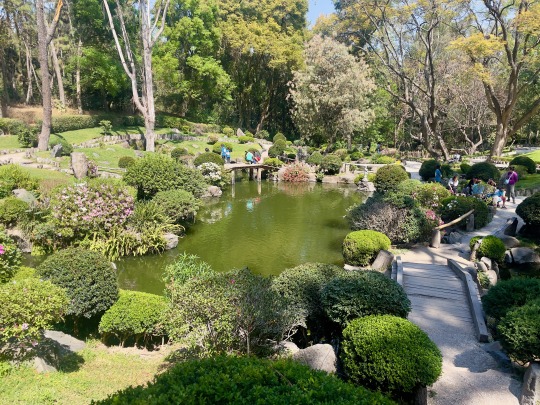
Cathie was still pretty low energy and was walking really slowly, so we didn't try to do more.
Our second stop was Basílica de Nuestra Señora de Zapopan, a Franciscan church and abby. It's the big Catholic Pilgrimage site in this part of Mexico.
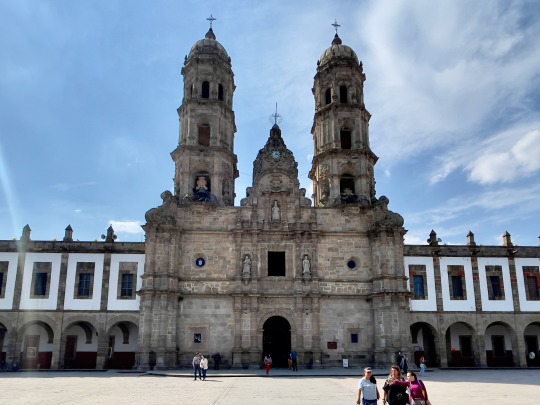

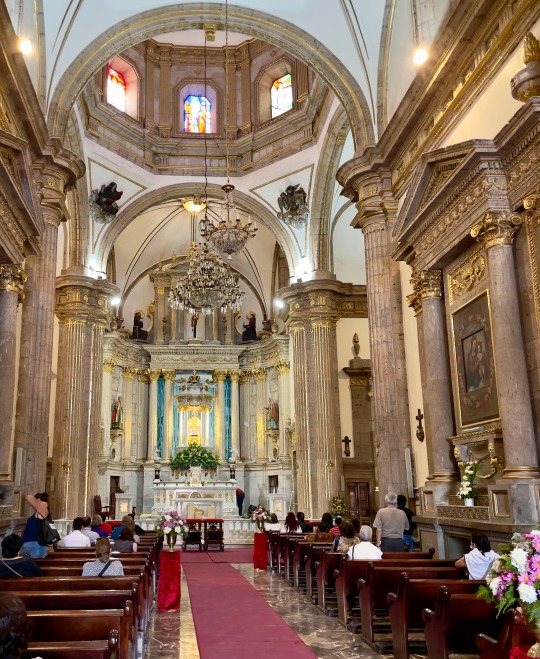
Among the statues of saints and such I noticed this statue of Our Lady of Transit. My guess is she probably died waiting for a bus.
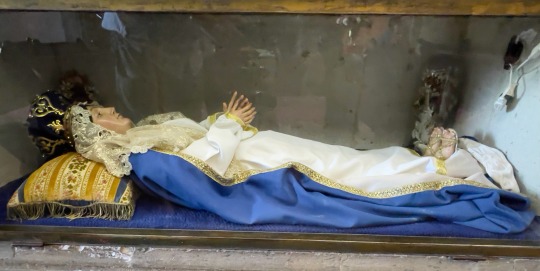
Then we decided it was time to had back and we hit the traffic of everyone else trying to get out of town. A one hour trip took two ans a half, so we were all pretty tired by the time we got back to the house.
The second time we tried to be smarter and went Sunday morning.
We started at the Cathedral of the Assumption of Our Lady in central Guadalajara. It contains altars dedicated to Our Lady of the Assumption, Our Lady of Guadalupe, Our Lady of Sorrows, Our Lady of Zapopan (patron saint of Guadalajara), Saint Dominic, St. Nicholas, St. Thomas Aquinas, St. Christopher and St. John of God, I guess there should be someone there for most issues you might have.
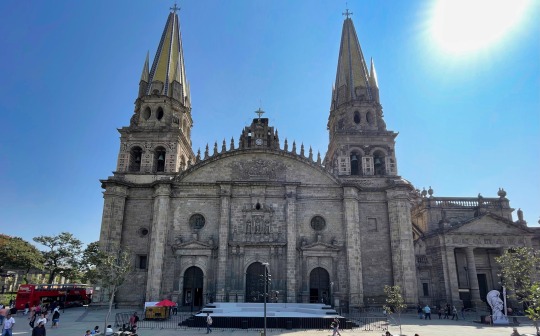
It's a large stone structure that looks to be in great shape, but I see it has suffered earthquake damage many time including in 2003. It's made of Cantera stone, a volcanic ash based stone common in México.
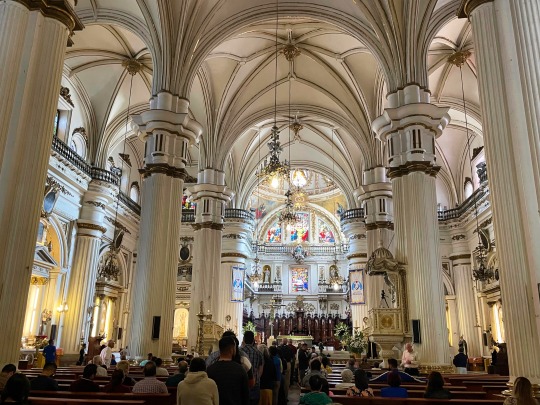
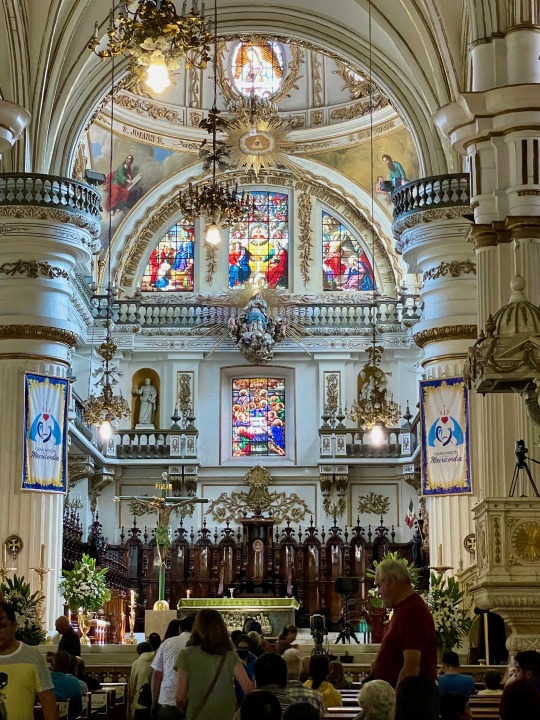
In the plaza beside the church they were constructing a large sculpture made of wood laths. It worked surrisingly well.
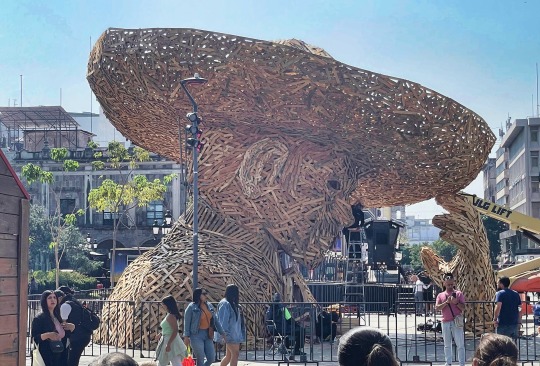
Then we walked to the Templo Expiatorio del Santísimo Sacramento, a Gothic style church, also of the same stone.
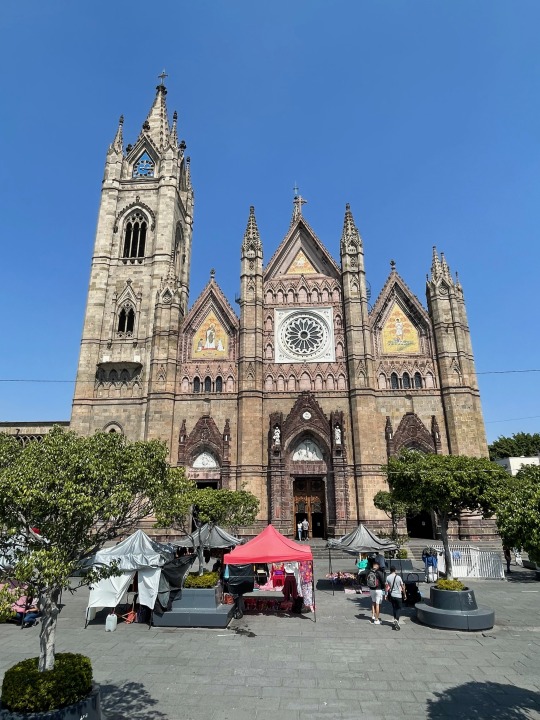
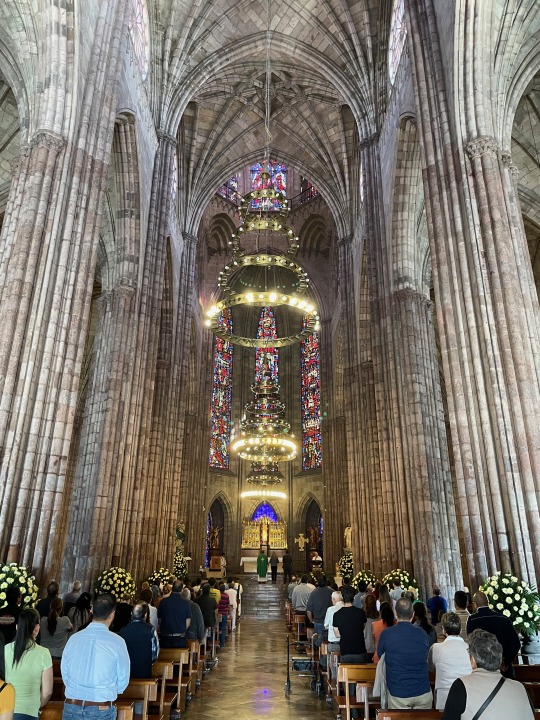
We also stopped at MUSA a small art museum associated with the local university. The murals in the theater were especially striking.
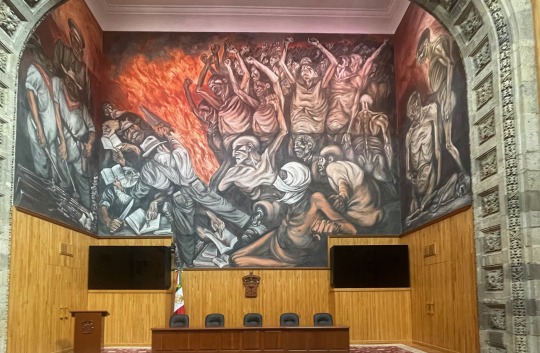
They seem to relate school to hell.
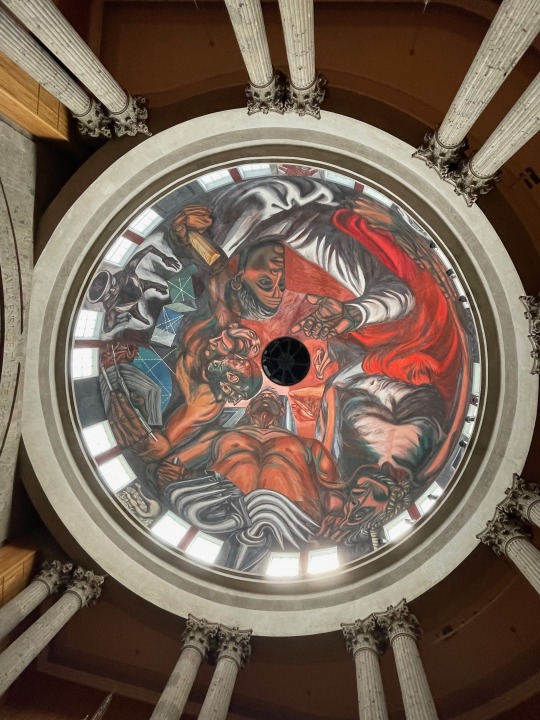
After that we hit a couple of the downtown markets plus the street markets along the way. I think we bought nothing. Yea!
On the way to the market we passed by the Teatro Delgado, a handsome building, but we were not able to get inside.
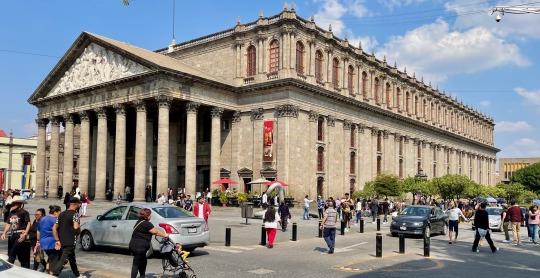
With that it was time for the drive back to our Ajijic home. Not too bad on a Sunday, but we are finding that the engine and air conditioning both overheat in slow traffic.
#guadalajara#Ajijic#Teatro Delgado#Templo Expiatorio del Santísimo Sacramento#MUSA#Cathedral of the Assumption of Our Lady
1 note
·
View note
Text
Pope Francis on Thursday called for solidarity against religious extremism during his visit to Indonesia, the world's most populous Muslim country.
The 87-year-old head of the Catholic Church highlighted the importance of unity to "defeat the culture of violence and indifference," during his visit to the Istiqlal Mosque, the largest in South-East Asia.
Pope Francis met with Grand Imam Nasaruddin Umar and signed a joint declaration which underscored values common across different religions to promote reconciliation and peace. They both expressed concern over climate change.
He and the grand imam stood at the entrance to the "Tunnel of Friendship," an underpass which connects the mosque compound with the neighbouring Catholic cathedral, Our Lady of the Assumption.
It was an "eloquent sign," Pope Francis said as the two places not only faced each other but were linked, allowing for "encounter, dialogue ... a genuine experience of fraternity."
On the third day of his visit, the pope later celebrated Mass in a football stadium before a congregation of more than 60,000, using his sermon to repeat his call for tolerance between the world's religions, dialogue and peace.
Pope Francis arrived in Indonesia on Tuesday, kicking off the longest foreign trip of his tenure so far, due to take him to four countries in South-East Asia and Oceania over the next 12 days.
With more than 240 million Muslims, Indonesia is the most populous Muslim country in the world.
On Friday, he will continue his journey to Papua New Guinea, before visiting East Timor and Singapore.
5 notes
·
View notes
Text
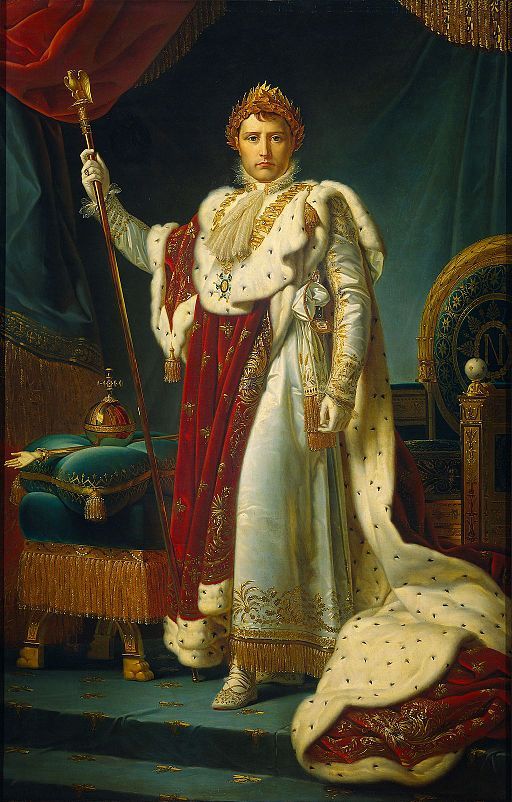
Happy birthday Napoleon!

The house in Ajaccio, Corsica in which Napoleon Bonaparte was born.
Napoleon Bonaparte was born on Tuesday, August 15, 1769, in Ajaccio, Corsica. France had acquired Corsica from the Italian city-state of Genoa the year before. Napoleon’s parents were Carlo and Letizia (Ramolino) Buonaparte. Their first surviving child, Giuseppe (Joseph), was 19 months old when Napoleon was born. Two older children, born in 1765 and 1767, had died in infancy.
August 15 marks the celebration of the Catholic Feast of the Assumption of Our Lady the Virgin Mary. Letizia was at mass in the Ajaccio cathedral when she felt severe labour pains. She left the service and walked the short distance to her house (Casa Buonaparte, now a museum), aided by Carlo’s sister Gertrude Paravicini.
Here, on a couch in the salon – for there was no time to reach her bedroom – with the assistance of Gertrude and a maid-servant, Mammucia Caterina, she was delivered of her fourth child – a boy, with a big head and a very intelligent face, who screamed loudly, and soon began sucking his thumb, which was considered a good augury among the peasants of Corsica.
Nine days later, Letizia turned 19 years old.
Nobody recorded anything about Napoleon’s birth at the time, and Letizia did not leave detailed memoirs. It wasn’t until Napoleon became a famous general that people became interested in his origins. Many myths sprang up surrounding his birth, which you can read about here (along with one element of Napoleon’s birth that might appear to be mythical but actually is not): https://shannonselin.com/2016/08/birth-napoleon-bonaparte/.
34 notes
·
View notes
Text

THE DESCRIPTION OF SAINT DOMINIC Patron Saint of Astronomers and Astronomy Feast Day: August 8
"One day, through the Rosary and the Scapular, Our Lady will save the world."
Dominic de Guzmán (Domingo Félix de Guzmán), the founder of the Ordo Praedicatorum (Order of Preachers aka Dominicans), was born in Caleruega, Kingdom of Castile (present-day Castile-Leon, Spain), on August 8, 1170.
In the earliest narrative source, by Jordan of Saxony, Dominic's parents are not named. The story is told that before his birth, his barren mother, Joan of Aza (Juana de Aza), made a pilgrimage to the Abbey at Silos, and dreamt that a dog leapt from her womb carrying a flaming torch in its mouth, and seemed to set the earth on fire. This story is likely to have emerged when his order became known, after his name, as the Dominican order, Dominicanus in Latin and a play on words interpreted as Domini canis: 'Dog of the Lord.'
Joan of Aza was beatified by Pope Leo XII in 1829.
After his ordination, he was assigned to the Burgo de Osma Cathedral, where he followed the Rule of St. Augustine. In 1204, as he was on his way to Denmark, he converted the owner of a hotel in Toulouse. This event made him realize that preaching was his special charism (or spiritual gift). Afterwards, he was sent by the Pope to convert the French Albigenses, and after a few years of intense preaching, accompanied by the example of a holy life, many people returned to the Catholic church.
To the monks of Cîteaux, whose efforts against the heretics were fruitless, he said: 'Arm yourself with prayer, rather than a sword; wear humility rather than fine clothes.'
One day, when being asked in what book he studied his beautiful sermons, he answered: 'In no other than the book of love.'
Together with a few missionary companions, he founded in Toulouse the Ordo Praedicatorum, or 'the Order of Preachers', whose members were dedicated to sacred studies and preaching.
They received official approval in 1216. Dominic advised his brothers in these words: 'Speak only of God, or with God.'
One day, he had a vision of the Virgin Mary, who instructed him to propagate the prayer of the Holy Rosary throughout the world.
On the feast of the Assumption in 1217, he sent the Dominicans in all directions, saying: 'We must sow the seed, not hoard it.'
Dominic spent a couple of years in Rome before taking up permanent residence in Bologna (present-day Emilia-Romagna, Italy). There, he died on the Feast of the Lord's Transfiguration - August 6, 1221, at the age of 50, worn out by a life of an intense apostolate.
#random stuff#catholic#catholic saints#dominicans#order of preachers#dominic of osma#dominic of caleruega#domingo félix de guzmán#domingo de guzmán
4 notes
·
View notes
Text


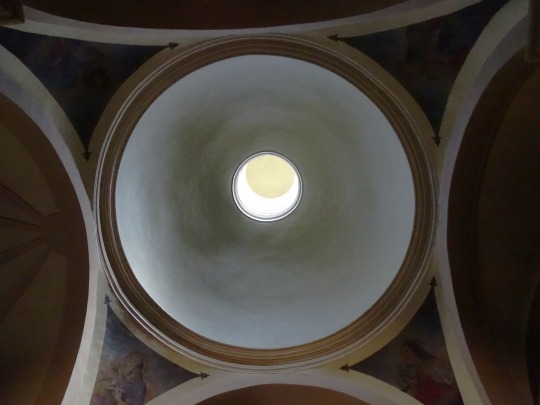

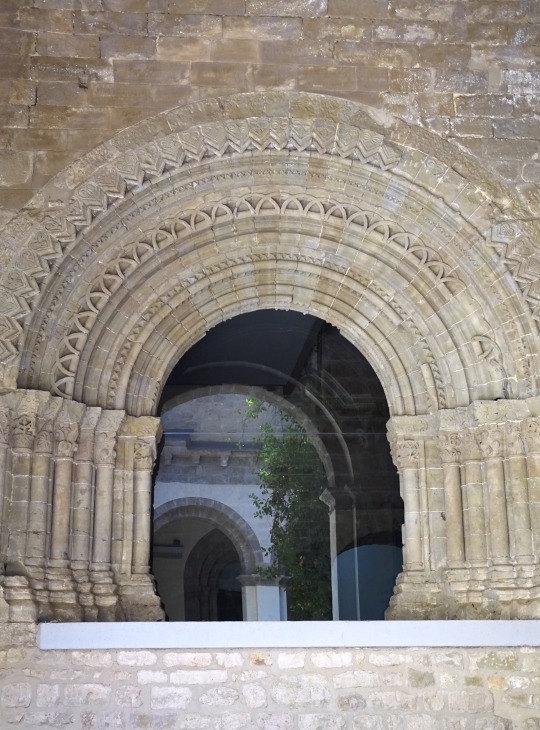

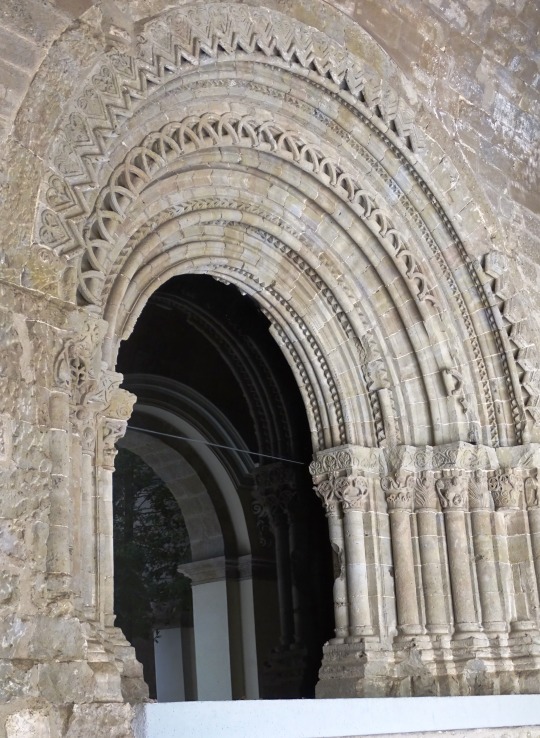

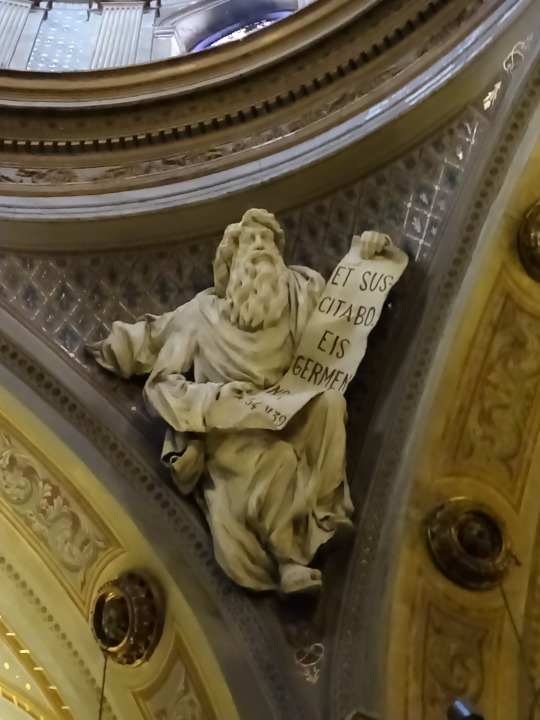

Solsona Cathedral, Spain (No. 6)
There is evidence of a pre-Romanesque temple dating 977. the Romanesque church was consecrated in 1070 and it is stated that it was “a most famous temple in the entire world”. From this time the three apses, the bell tower, some pieces from the cloister, the cellar and the canons’ dining hall, (these days used for different events) have been preserved.
The cathedral today is Gothic and it was begun at the end of the 13th century and finished in the 17th century and finished in the 17th century. On the left of the transept there is the chapel of Mercè with a Baroque altar from the artist Carles Morató. On the right there is the venerated image of la Marededéu del Claustre from the 12th century and catalogued as one of the most important Catalan Romanesque sculptures.
It is easy to imagine the upheaval that the creation of a bishopric in Solsona in 1593 meant for the beautiful medieval Collegiate Church of Santa Maria, which was now to become a cathedral, particularly in regard to renewal of ornamental elements and the making of new altarpieces.
THE HIGH ALTAR (DEDICATED TO THE VIRGIN MARY)
The high altar dedicated to the Virgin Mary was commissioned from the Majorcan sculptor Miquel Vidal (1634), but it was not completed, except for six large panels sculpted in low relief from the predella, which are conserved in the Solsona Diocesan and Regional Museum. Nor does anything remain of the second high altar, commissioned from Jacint Morató in 1730: the dreadful fire caused by Napoleon’s troops in 1810 destroyed it along with many other works. Following this disaster a new high altar was made (1854-1856), the third. However, it was short-lived, as it too was burnt during the Spanish Civil War. Fortunately, six of eight paintings by the distinguished Nazarene artist Claudi Lorenzale survived.
THE CHAPEL OF OUR LADY OF MERCY AND THE SACRISTY FURNISHINGS (TWO BAROQUE WORKS THAT SURVIVED THE FIRE OF 1810 AND THE SPANISH CIVIL WAR)
Only two sets of works from the modern period escaped the fire of 1810 and the later ravages of the Spanish Civil War on the cathedral. These are the Chapel of Our Lady of Mercy and the walnut cupboard and drawers in the canons’ sacristy. The first contains the dynamic altarpiece sculpted around 1750 by Carles Morató, although the sculptural elements were lost. The sacristy holds a beautiful cupboard with painted doors and the reliquary busts of Saint Victoria and Saint Secunda, of fine quality. Unfortunately, the artist is unknown. However we do know that the author of the colourful doors of the reliquary cupboard was Antoni Bordons.
THE CHAPEL OF OUR LADY OF THE CLOISTER
The Chapel of Our Lady of the Cloister (1727-1776), designed to house the prized Romanesque carving, was destroyed on several occasions. Its complex construction, which was also to have an altarpiece and mural paintings, was commissioned from Jacint and Carles Morató—who worked in collaboration with sculptor Josep Sunyer i Raurell. It disappeared due to damage incurred in 1810, 1822 and 1936, but from old descriptions one gathers that it must have been a most impressive example of Catalan Baroque.
OTHER NOTEWORTHY ELEMENTS FROM THE MODERN PERIOD
Elements that should not escape our notice are the modest baroque reredos at the foot of the nave, the work of Isidre Clusa, classical in style and decorated with naive reliefs showing from the life of Saint Martin, originally from the Church of Sant Martí de Riner, although it is disconcerting to see it now topped by a Saint Michael; and the fine groups of sculptures decorating the cathedral’s late eighteenth-century facades, with representations of ‘The Assumption of the Blessed Virgin Mary’ (1768) and ‘The Ecstasy of Saint Augustine’ (1780).
Source
#Cathedral of Santa María de Solsona#Cathedral of Solsona#España#Southern Europe#Nucli antic#travel#original photography#vacation#tourist attraction#landmark#architecture#cityscape#exterior#detail#old town#summer 2021#Northern Spain#interior#tree#courtyard
3 notes
·
View notes
Text
Miraculous Image of Our Lady of the Assumption, Dauis, Bohol, Philippines
Pintakasi PH, a popular Catholic blog in the Philippines, relates this beautiful story of how Our Lady travelled over the sea to "be near" St. Joseph (the Cathedral of St. Joseph in Tagbilaran is very near the Church of Our Lady of the Assumption, Dauis).
Our Lady of the Assumption, Dauis has recently given a pontifical coronation last August 15, 2023.

Nuestra Señora de la Asuncion de Dauis: the Miraculous Pensive Lady of Dauis, Bohol – Pintakasi (wordpress.com)
History is silent on where the image came from and who carved the image. During the 18th century, a tale was mentioned about a lady hailing from the town of Dalaguete in Cebu. She asked a banca drawer to ferry her to Mariveles (old name for Dauis). Afraid that the lady will not endure the rough sea conditions, the man refused the lady’s pleading. The lady kindly insisted that he’ll bring her to Mariveles, to which the man in the end agreed. She said she wanted to be near her husband. It was said that during the ride, the man did not experience turmoil in the seas. Instead, he felt that the boat that they were riding seemed to float in the air. When they were nearing Mariveles, he heard the lady spoke: “Duol na ang Mariveles” (Mariveles is near).
Docking near the church, the man turned his back to where the lady was seated. But to his amazement, the lady was no longer there. In her stead was a little camiseta, which he remembered the lady was brought during the trip. Startled, he hurried inside the then newly-built Dauis Church, only to be stunned once more when the lady showed semblance to the image of the Virgen de la Asuncion in the main altar. And true enough (as the lady previously said that she wanted to be near her husband), the Church of Dauis can be seen not far from the imposing church of St. Joseph in Tagbilaran City. This miracle is foretold in the Gozos in her honor and this event is commemorated every Last Sunday of January as a Secondary Feast.

All photos by MTQS Photography.
5 notes
·
View notes
Text
A Walk Through Time: Key Historical Landmarks in Haïti You Must See
One of the most iconic landmarks in Haïti is the Citadelle Laferrière. Located
Haïti, a nation with a vibrant and tumultuous history, is home to numerous historical landmarks that reflect its cultural heritage. From colonial architecture to revolutionary sites, these landmarks tell the story of a nation that fought for its independence and identity. Exploring these sites offers a glimpse into the past and an understanding of Haïti's significance in world history.
The Citadelle Laferrière
One of the most iconic landmarks in Haïti is the Citadelle Laferrière. Located in the northern region of the country, this fortress was built in the early 19th century to protect against potential invasions from France. The Citadelle is a UNESCO World Heritage Site and is considered a symbol of Haitian freedom. Its impressive architecture and stunning views of the surrounding landscape make it a must-visit for anyone interested in history.

Palace of Sans-Souci
Adjacent to the Citadelle Laferrière is the Palace of Sans-Souci, another UNESCO World Heritage Site. This palace was once the residence of King Henri Christophe, a leader in the Haitian Revolution. The ruins of the palace tell the story of the grandeur of the Haitian monarchy and the tragic downfall that followed. Visitors can explore the remnants of this once-majestic structure and learn about its historical significance.
The Iron Market
In the heart of Port-au-Prince lies the Iron Market, a bustling marketplace that has been a vital part of the city's economy for over a century. Originally built in the 19th century, the market has undergone several renovations due to fires and natural disasters. The Iron Market is not only a place to shop for local goods but also a historical landmark that reflects the resilience of the Haitian people.
The National Palace
The National Palace, located in Port-au-Prince, was the official residence of the President of Haïti until it was severely damaged in the 2010 earthquake. The palace's neoclassical architecture is a testament to the country's colonial past. Although it is currently under reconstruction, the site remains a symbol of the Haitian government and its history. Visitors can learn about the political history of Haïti and the significance of the palace in the nation's governance.
The Museum of Haitian Art
For those interested in the artistic heritage of Haïti, the Museum of Haitian Art is a must-see. This museum showcases the works of Haitian artists and highlights the country's rich artistic traditions. The museum is housed in a historic building that adds to its charm. Visitors can explore various exhibitions that reflect the cultural influences and historical events that have shaped Haitian art.
Fort Jacques
Fort Jacques is another historical landmark that played a crucial role in the defense of Haïti during its early years. Built in the early 19th century, this fortress was strategically located to protect Port-au-Prince from foreign invasions. Today, visitors can hike to the fort and enjoy panoramic views of the surrounding area while learning about its historical significance in the context of Haitian independence.
The Memorial of the Victims of the Earthquake
In memory of the lives lost during the devastating earthquake in 2010, the Memorial of the Victims of the Earthquake serves as a poignant reminder of the resilience of the Haitian people. This memorial is located in Port-au-Prince and honors those who perished in the disaster. It is a place of reflection and remembrance, allowing visitors to pay their respects and learn about the impact of the earthquake on the nation.

The Cathedral of Our Lady of the Assumption
The Cathedral of Our Lady of the Assumption, located in Port-au-Prince, is a significant religious and historical site. Originally built in the 18th century, the cathedral was heavily damaged during the 2010 earthquake. Despite the destruction, efforts are underway to restore this iconic structure. The cathedral's architecture and historical importance make it a notable landmark for visitors interested in Haiti's religious heritage.
Conclusion: A Journey Through History
Exploring the historical landmarks of Haïti offers a unique opportunity to understand the nation's past and its journey towards independence and resilience. Each site tells a story of struggle, triumph, and cultural richness. Whether visiting the Citadelle Laferrière or the Iron Market, travelers can immerse themselves in the history that has shaped Haïti into the vibrant nation it is today
0 notes
Text
youtube
Pope Francis is in Jakarta, Indonesia for Apostolic Journey 2024 Holy Father Pope Francis started the Apostolic Journey 2024 in Jakarta, capital of Indonesia. He then went to Papua New Guinea, Timor-Leste and Singapore. Watch the convoy from The Church of Our Lady of the Assumption (Jakarta Cathedral) to Istiqlal Mosque in Jakarta, Indonesia. Have you seen Pope Francis up close? When and where, please comment it below. #Church #Indonesia #PopeFrancis CYBERTITO – the uncle who loves information technology. From tech tips, web tutorials, poems, OFW life, BPO work, travels, and Catholicism, there's always something new. Explore with CYBERTITO! Subscribe for more videos about Art, Life, Tutorial, Travel, and Catholicism! https://bit.ly/CYBERTITOYouTubeChannel Follow CYBERTITO on social media Facebook Fan Page: https://www.facebook.com/cybertitojj Facebook Profile: https://www.facebook.com/JosephRaymundEvangelistaEnriquez TikTok: https://www.tiktok.com/@cybertitojj Visit CYBERTITO website https://cybertito.com/ Copyright (C) CYBERTITO – All Rights Reserved.
0 notes
Text
Granada Cathedral, Granada, Nicaragua: The Our Lady of the Assumption Cathedral also called Granada Cathedral is a neoclassical Catholic cathedral located in Granada, Nicaragua, 40 kilometres southeast of Managua. The church is the main temple of the Diocese of Granada, and its bishop is Jorge Solórzano Pérez. Wikipedia
#Cathédrale Notre-Dame de l'Assomption#Granada Cathedral#Granada#Nicaragua#Central America#north america#north america continent
177 notes
·
View notes
Text

Sao Paulo Cathedral, Brazil: The Metropolitan Cathedral of Our Lady Assumption and Saint Paul, also known as the See Cathedral, is the cathedral of the Roman Catholic Archdiocese of São Paulo, Brazil. Wikipedia
180 notes
·
View notes
Text
. ʙ ᴇ ᴀ ʀ ɪ ɴ ɢ ꜱ .
. ꜱ ᴀ ɪ ɴ ᴛ . ꜰ ʟ ᴇ ᴜ ʀ .

. ɢ ᴇ ɴ ᴇ ʀ ᴀ ʟ .
Well off the beaten path, SAINT FLEUR is a small hillside town famous for its figs. The town has narrow cobbled streets, many of which overlook a valley, and many medieval and Renaissance buildings, and a castle.
While exploring the town centre you will see many interesting medieval houses, small picturesque shady squares and the ornately carved 16th century Renaissance-style entrance to the Hôtel des Fleurs.
On a hot day, Saint Fleur, with its unusal number of waterfalls, fountains and ancient lavoirs, feels cool and refreshing. (As well, there are three small rivers which run alonside the town and attract a fair amount of recreational swimmers.) And, on its squares, there are shady café terraces beneath towering plane trees.
Open-air market on warm weather Sundays.
. ᴘ ʟ ᴀ ᴄ ᴇ ꜱ . ᴏ ꜰ . ɴ ᴏ ᴛ ᴇ .
The Collegiate Church of Our Lady of the Assumption ~ The local cathedral has never once been entered by a Fell, but architecturally speaking, it is very much a treasure and the focal point of Saint Fleur.
Hôtel des Fleurs ~ The current uncontested seat of illicit local liasons. It's a fine historical building with charming Edwardian decor and old-timey chatelaine-decked "house keepers".
Market Square ~ Flourishing with people immediately following Mass on Sundays. Locals flock to stalls of flavoured ice, handsewn goods, ceramic odds-and-ends, fresh chocolatine, and so on. Apart from being a well-established market, it's also /the central Saint Fleur (gathering place outside of the church, of course).
Médiathèque Florencia Gable ~ The only library in Saint Fleur. It happens to have a rather strange, musty "basement" area carved out of the earth for quiet reading.
Le Café de la Fontaine Rouge ~ A tiny café located on the slanted Red Fountain Square of Saint Fleur. It's far too hole-in-the-wall to have in-door seating, and therefore its terrace-seating only. When the weather is not amenable, the café is closed.
Le Café de la Fontaine aux Champignons ~ The Mushroom Fountain Square-located café, directly opposite the old cinema house.
The Cinema ~ It doesn't show anything new- hasn't since the premiere of "Raphaël ou le débauché" in the 70's. But every now and then its purveyor, the elderly Mrs. Rebecca Zelle, decides/is persuaded to show an oldie but a goodie for a couple of nights only.
The Ancient Water Garden ~ A Medieval stone garden of water features in which children (and adults) use to keep cool. There are fountains (of course), a communal lavoir (used by the ancient denizens of Saint Fleur to wash clothes), and shallow bathing pools containing ancient stone fish-shaped spouts which cascade umbrella streams of cool water straight up into the air.
Verte Fontaine Sushi ~ A "health food" Japanese restaurant in Saint Fleur's Green Fountain Square.
Chez Chiffon ~ French-Mediterranean cuisine in a swanky Art Nouveau setting. Seating indoors, but in warmer weather, all meals are taken on the fountain studded terrace.
La Pause Gourmande Patisserie & Tea Room ~ The "dignified" ladies of Saint Fleur gather together here on Friday mornings to indulge in a little gossip and freshly-made petite madeleines. If you were wondering, a Fell is as likely to be invited to such a gathering as they are to set foot in the cathedral.
La boucherie ~ The butcher's shop.
Club Ombra ~ A rather clandestine nightclub, tucked well out of the way of the central Market Square.
Cascade du Reliquaire ~ The largest waterfall on the Polyphemus River. It attracts a fair amount of tourists, and locals like to avoid the area as a result of all the foot-traffic. That said, it's a beautiful area- the rocks are completely carpeted in moss and the cascade, spliting into lots of smaller falls, resemble ethereal bridal veils draped over the hillside.
La Grotte d'Aenaia ~ One of many grottoes on the outskirts of Saint Fleur, but Aenaia's is popular for its ancient columns and frescoes, lending it the distinct feel of being a pocket out of time. A place for naiad revels, some say.
River Acis ~ The smallest of the three rivers circumnavigating Saint Fleur. The Acis' distinction from its sibling rivers is its remarkable crystal green waters.
River Galatea ~ The second smallest of the three Saint Fleur-adjacent rivers. The waters of Galatea run a bit rougher than the other two- in fact, it's too dangerous to traverse in the rainy season.
River Polyphemus ~ The largest, and most popular, of the three Saint Fleur rivers. In the summer, people enjoy swimming, tubing, and even fishing on the Polyphemus.
. ᴄ ᴀ ꜱ ᴛ ʟ ᴇ . ꜰ ᴇ ʟ ʟ .

. ᴇ x ᴛ ᴇ ʀ ɪ ᴏ ʀ .
What is now referred to as "Castle Fell" is, in fact, a centuries-old keep surrounced by time-worn stone walls and well-hidden from view by a thick over-growth of ancient foliage (which somehow does little to mask the cloying scent of the grounds' massive and ancient red rose garden, mind you).
It's retained it's imposing arches (from what anyone can tell)- but upon Malfante Fell's obtaining of the castle in the early 90's, it's structures have since been safely (if not faithfully) reinforced. The outer walls and gatehouse have remained somewhat untouched, but more modern touches have come about by way of electricity, plumbing, heating/cooling systems, etc.
The Rose Garden ~ Prevalent and of vital importance to the integrity of, not only the orignal body of land the castle resides upon, but also the man and family who occupy said land, the ancient red rose garden takes up a great deal of Castle Fell's landscape. These roses not only out-grew the original garden but also managed to choke the life out of anything else living and growing in their path. They are considered "parasitic", in a sense, as their relationship with the master of Castle Fell is, indeed, symbiotic. They also happen to feed on a certain kind of blood rather than water like any other plant. The Fells imagine this fact gives them their extra-ordinary red colour. They do not abide "human" touch, have consumed strange meats, and despite emitting an admittedly "amplified" rosy aroma, have often caused locals to sicken merely at their smell. [As a side note, the Fells do not keep small pets.]
. ɪ ɴ ᴛ ᴇ ʀ ɪ ᴏ ʀ .
More modern renovations within are far more steep than without. Electricity alone has made the castle into another creature entirely (to say nothing of plumbing and everything else that comes along with modernity). However, the "Wives" were insistent that some of the rooms, particularly "bedchambers", should retain their historical charm if at all possible. And, thus, many of the Fells find themselves living in a bizarre amalgam of Arthurian-esque and twenty-first century interior design. The result is eclectic and anachronistic moreso than any straight-forward aesthetic. A certain charm particular to the Fells.
. ꜰ ᴇ ᴀ ᴛ ᴜ ʀ ᴇ ꜱ .
30 bedrooms and 47 modern lavatories
Great Hall replete with original tapestries, massive fireplaces on either side of the room, and a single sturdy oaken table for sharing meals
Extensive underground kitchens, a larder and pantry room
Several so-called "drawing rooms" and private studies, only one of which is barred from use by the Wives and children of the family
No shortrage of subterranean storerooms, a vaulted undercroft (currently being used as a bedroom), and cellars
A defunct-dovecote, once used by the Fell children as a sort of secret playhouse
0 notes
Text
What it’s like to be a Catholic in the world’s largest Muslim country
The Catholic Cathedral of Our Lady of the Assumption in Jakarta, Indonesia. / Credit: EWTN News Jakarta, Indonesia, Sep 3, 2024 / 06:08 am (CNA). As a Catholic living in the world’s largest Muslim country, Baso Darmawan does not think twice about making the sign of the cross as he prays before a meal at a restaurant in the bustling capital of Jakarta. Darmawan says that he personally knows many…

View On WordPress
0 notes
Text
Day 9 - 14 September - Belgrade
We got up and went to the train station to book our sleeper train to Montenegro on Sunday night, however lots of the streets were closed by the police and there were armoured vehicles and police dogs around which was slightly intimidating. We did manage to get to the station and then book the train, (we initially thought we had got a private cabin but the lady had booked us on the Saturday train and there were only couchettes for Sunday, however this will hopefully be better than the night bus or sleeping on across 3 seats like our last night train).
We then went and spent the most opulent £16.90 I’ve ever spent at breakfast at this bib gourmand restaurant. It was a modern take on Balkan food and I had this polenta portage with blue cheese and mushrooms and Nin had cold oatmeal with every nice fruit under the sun on it. Considering we had that and 4 coffees, I couldn’t believe the price!
The breakfast was quite heavy so we went home to chill for a bit and then went on another excellent free walking tour. The guide was a very dry woman (i think called Ivana) who spoke through lots of different things, such as the three main architectural styles of Belgrade; Habsburg (very much friends of the blog at this point), brutalist, modern (she really did not like the modern stuff). We walked down the street our apartment is on, and then into the more hipster part of town that during the time when organised crime most ran the country in the early 00s was called silicone valley because of the breast implants of the mob wives who went to the clubs there. This is also where the oldest families in Belgrade live in, as there are very few people whose families have lived continuously in Belgrade for generations (apparently the city empties on orthodox holidays as everyone goes back to their village or town).
Although Belgrade was very Ottoman for hundreds of years, almost nothing of this architecture remains bar a couple of houses. She spoke through the Serbo/Croat language and the fact that it has two scripts (Cyrillic and Latin) because when Serbia and the rest of Yugoslavia merged Serbia used Cyrillic and Slovenia/Croatia used Latin and since the languages are the same, both scripts are usable.
We went to Belgrade castle which is absolutely massive and has an amazing view down onto the confluence of the Sava and Danube rivers. The tour finished in the orthodox cathedral where there was a wedding on. Serbian weddings seem to be soundtracked by gypsy brass bands who seranade the bride as she enters the church. It was fun and very over the top.





Our tour guide was interesting, on one hand, she was very liberal in her views and spoke a lot about government corruption and hoping all the things from the Yugoslav wars were behind the region. On the other hand she was very clearly Serbian in of her outlook, she crossed herself going into the cathedral, she preferred the Cyrillic script to the Latin, and was very proud of her Serbianness (if thats a word). Her explanation of the place of rakija in Serb culture was really interesting and heartfelt. I think that sometimes there is an assumption people in the east of Europe want to be like people in the west of Europe, but that that view I think is lazy and quite condescending (even if we can all stray into it) and that there are loads of ways to be a good person and be a good society. And nice liberal people from metropole cities in Western Europe don’t have a monopoly on a good life and we have lots of faults and blind spots that we don’t often interrogate.
After the tour we went to a grill called GrillRepublik which had 4.9 stars on google (‘unheard of’ Nina Jones) they were playing the Liverpool game which was nice I hadn’t watched any football since the season started. The food was so good we both had burgers with kajmak on it which is a Balkan cream thing that is half way between butter and clotted cream. It was delicious but I think dangerous to have on meat like that. My burger came with cabbage and I got a shopska salad, Nin had onions and a slightly different salad. The bread we had was also very fresh and airy. This was supposed to be a little snack so we got the small burger, but it was so big we could just about finish it!
After food, we went home and chilled out for a bit and then went to this fun bar for a couple of drinks (it was Saturday night after all), however we were both quite tired and so we left and went for a little walk and then went back to our apartment, I published my blog from Sarajevo and we did some planning and got a relatively early night.
What we ate - Iva New Balkan Cuisine, GrillRepublik
What we liked - My polenta thing got quite heavy after a while so i think the grill was the best thing of the day.
Day 10 - 15 September - Belgrade > Bar
We were planning to go for a run before we checked out but it was absolutely lashing when we work up so we just had a coffee in the flat and packed. When we left we went to do laundry in a laundrette, which was needed as we hadn’t done any washing since Zagreb! There were lots of tourists there trying to wash (or dry) their stuff. Walking there had been a bit of a mission and I am very thankful for the waterproof cover for my bag!
We then went and stored our stuff in a luggage storage and looked for place for lunch, we found this very classic boogie coffee shop/brunch place. I had this french omelette with mushrooms which was amazing, I think I said it was one of the best omelettes id ever had, not sure if that was hyperbole or not but it was good! It was probably one of the most expensive meals we had had since Slovenia (about £33) but the space was very nice and the food was good!
After that we failed at getting a bus to the Museum of Yugoslavia, so in the end got a taxi. It is quite a random museum, and mainly houses The Big Man’s (Tito’s) mausoleum and then a museum bit that seems only there to house the presents that he got from other world leaders, among some other things about the formation of Yugoslavia. The most numerous thing in the museum was relay batons from Youth Day celebrations over the years, my main thought was that I just want someone to love me like Tito loves relay batons.
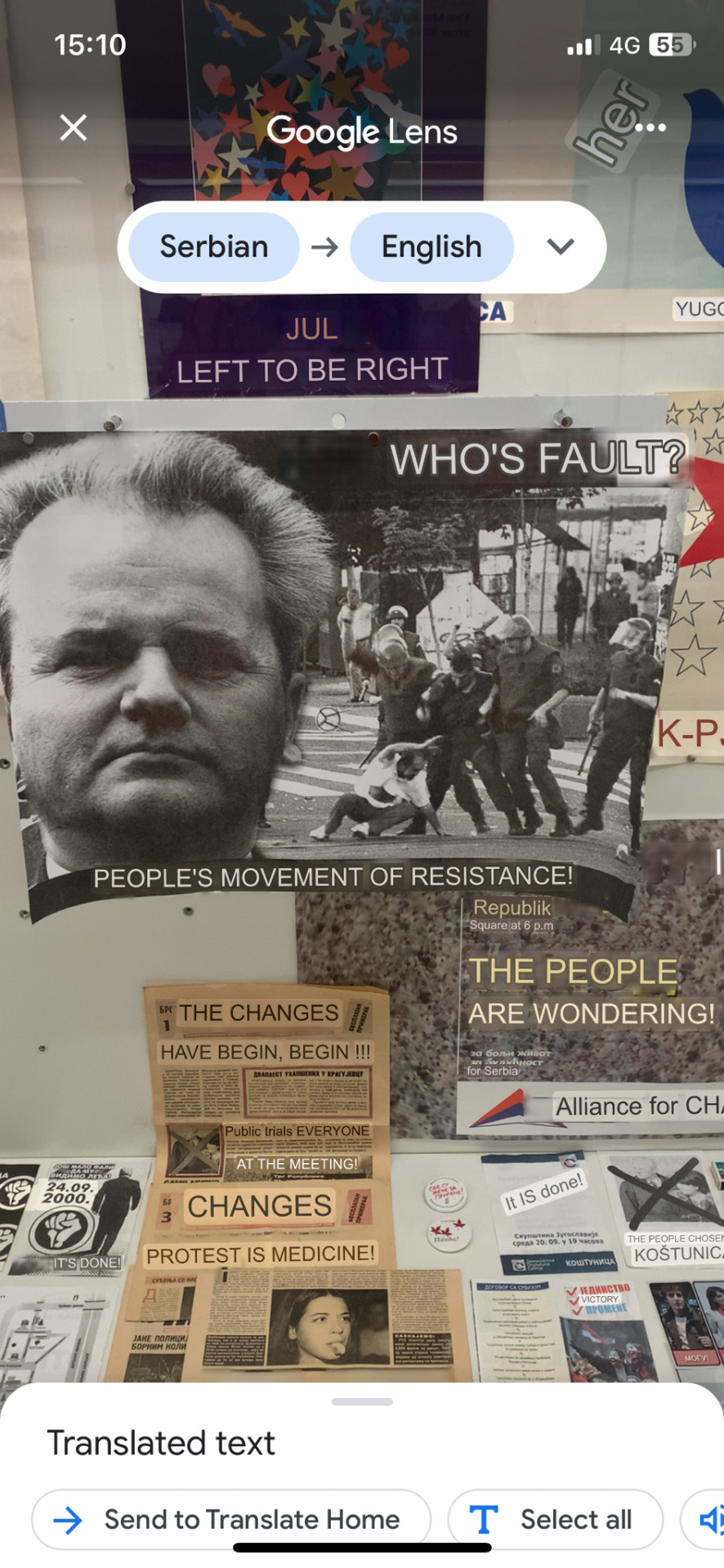

After the museum, we walked to St. Sava’s temple which is the second biggest Orthodox Church in the world. It was pretty amazing and I think had been restored quite recently and was latterly shining gold. The pictures I took do not do it justice. They were also piping in some sick plainchant music which added to the atmosphere.

We then walked back into town (the other two places had been a bit out of town) via a Boots/Superdrug type shop, which in the rain and after being in lots of cites that id never been to before felt strangely comforting (something about the lighting and familiarity), even though we didn’t get anything. We went to the National Museum of Serbia, which is mainly an art gallery with some early artefacts on the second floor. The art was pretty good, would have liked a bit more socialist realism, but there was some great stuff there (it was free and in the main square too!)

We then went to a Vietnamese (Asian fusion really) that was in the bib gourmand but was really just fine, I think in London we are spoiled it’s Pho Mile. We then got our bags and got a taxi to the station. The driver said he hoped Putin sent nuclear bombs on the UK as he showed us a building that had been destroyed in nato bombing (good thing I said we were Irish).
I enjoyed Belgrade much more than I expected to, particularly after being in Sarajevo and Republika Srpska, and reading and hearing about how the Serb Government is acting and its close relationship to Russia. I guess it is true that most people are generally friendly and welcoming and that politics generally sits above individual interactions with people. It also feels like Belgrade is pretty liberal (particularly the places we went), and I doubt the rest of the country is quite like that. Our taxi driver slightly shattered that assumption, but looking at his age, he could well have been in the Yugoslav army at the time of the wars, and what would an experience like that do to someone. It takes lots of courage and self reflection to go against the view of an institution you are part of, particularly if you hear of atrocities committed by the other side (real or not), and NATO are bombing your country. The graffiti below is from the main square in Belgrade, written in English with stencils of Radovan Karadžić beside it, even with all the perceived liberalism in Belgrade, this politics is impossible to ignore.

We were very early for our train and when it came we were both top bunks in a couchette. We have definitely got our night travel better and a night train is definitely preferable to night bus. The guy in the bunk below me snored quite a lot and my noise cancelling headphones ran out of battery at about 1am! I think I slept a bit and am definitely not as tired as after the bus. At about 8am I woke up and went to look out the window, the train we were on is famously very beautiful and it was a very nice view to wake up to, first the mountains then Skroder lake! We are now in a coffee shop in Bar waiting for our check in at 2 to our hotel down the coast. The weather is much nicer here so let’s hope it stays that way!
What we ate - June cafe, Istok
What we liked - June was nice, Istok i would say is overrated but wasn’t bad.
0 notes
Text
Rouen Cathedral fire brought under control
Firefighters have finished extinguishing the spire of a cathedral in France’s Rouen, the city hall said.
The fire broke out around noon on Thursday at the Cathedral of Our Lady of the Assumption where renovation work was underway, local prefecture and fire service officials said. The Gothic cathedral, one of France’s finest, dates back to the 12th century and was painted several times by impressionist painter Claude Monet in the 19th century, achieving worldwide fame.
Footage from French television channel BFM, released shortly after the fire started, shows a thick plume of smoke rising from the cathedral’s central spire and people in the streets looking up in horror. Read more HERE

#world news#news#europe#european news#european union#eu news#rouen#rouen cathedral#cathedral#normandie#breaking news#todaynews#today on tumblr
0 notes